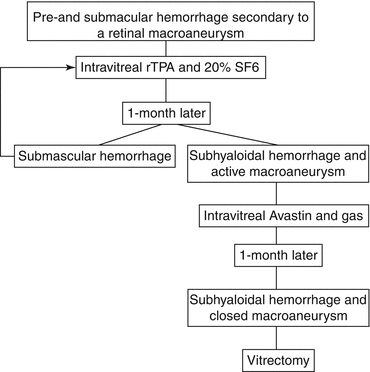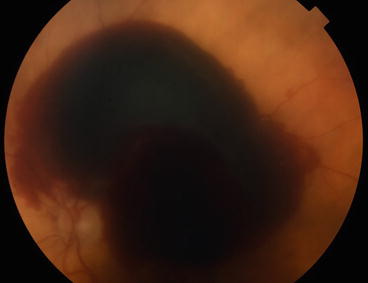and Mitrofanis Pavlidis2
(1)
Department of Ophthalmology, Uppsala University Hospital, Uppsala, Sweden
(2)
Augencentrum Köln, Cologne, Germany
23.1 General Introduction
Electronic supplementary material
The online version of this chapter (doi:10.1007/978-3-319-20236-5_23) contains supplementary material, which is available to authorized users.
Electronic supplementary material
for this chapter is accessible online at http://extras.springer.com/ by searching via the ISBN.
Video 23.1: Submacular hemorrhage secondary to macroaneurysm
23.1 General Introduction
A retinal macroaneurysm has a better prognosis and is usually caused by high blood pressure. It results into a subretinal, sub-ILM, subhyaloidal and preretinal haemorrhage. The latter may break into the vitreous body. It is tempting to perform a vitrectomy, inject rtPA into the subretinal space and aspirate the blood. It is however difficult to treat the macroaneurysm because it may easily bleed destroying all the surgical progress you made. We perform only a treatment with rTPA and gas and Avastin. First, the preretinal and intravitreal haemorrhage subsides. Then a subhyaloidal haemorrhage persists. The retinal macroaneurysm is still open. You can treat now with gas and Avastin. If the subhyaloidal and the sub-ILM haemorrhage do not resorb, you can remove it with a vitrectomy. Conclusion: Be cautious with a vitrectomy and be generous with intravitreal treatments. See Flow chart 23.1.


Flow chart 23.1
Our treatment algorithm for retinal macroaneurysm
Case Report No. 15: Retinal Macroaneurysm 1
Figs. 23.1, 23.2, 23.3, 23.4, 23.5, 23.6, 23.7 and 23.8


Fig. 23.1




Case report 15: a small preretinal and large subretinal haemorrhage secondary to a retinal macroaneurysm. rTPA and gas are injected
Stay updated, free articles. Join our Telegram channel

Full access? Get Clinical Tree


